Bagging apple fruit for codling moth control
A simple and effective method for the hobby grower?
This project is supported by a Montana Department of Agriculture Specialty Crop Block Grant.
Background
Apple (Malus domestica) fruit are susceptible to codling moth (Cydia pomonella) larval infestation from June through September in Western Montana. Commercial management for codling moth requires continued attention to predicted codling moth life stages and multiple pesticide applications. However, hobbyist apple growers are less likely to invest the time, equipment, and education required for this level of pest management. A potentially simpler alternative involves bagging individual apple fruit or whole trees early in the season to reduce oviposition and subsequent larval infestation. We tested various methods of individual fruit and tree bagging over three growing seasons in WARC's 30-year-old 'Cortland' apple orchard.
Summary
Young apple fruit were bagged with Ziploc sandwich bags in 2019 (Leisso, Jarrett, and Miller, 2021) and with stretchy nylon bags (Maggot Barriers, or MBs) in 2020. Shortly after petal fall, fruit clusters were first thinned to one fruit per cluster and the remaining fruit were bagged to reduce the incidence of oviposition prior to bagging. Ziploc bags significantly reduced infestation (down to 10% from 34%); however, the process of thinning clusters and bagging individual fruit was time-consuming (1 min, 33 sec per cluster in 2019 for Ziplocs; 1 min and 7 sec per cluster in 2020 for MBs), and many bags fell from trees prior to harvest (likely due to high winds, natural fruit drop, and bags slipping off fruitlets that were too small). The Ziploc bags also seemed to attract earwigs (order Dermaptera), and their frass in the fruit stem bowl made the harvested fruit unappealing.
In 2021, we repeated 2019 and 2020 treatments (with modifications) and added a whole tree bagging experiment. Just prior to bagging, we sprayed horticultural oil on half of the total number of trees in an effort to smother first-generation codling moth eggs. For the individual fruit bagging experiment, we used Ziploc bags, MBs, and MBs treated with a kaolin solution. In a second experiment, we covered entire tree canopies with large bags made from agricultural insect barrier netting. The kaolin-treated MBs won inhibited codling moth activity better than Ziploc bags. However, the tree canopy bags showed the most promise among bagging treatments, as codling moth damage affected less than 10% of fruit, bagging time was markedly less than for bagging individual fruit, and sturdy agricultural netting can be reused for multiple seasons. The horticultural oil treatment reduced codling moth damage to individually bagged fruit but not to fruit enclosed within canopy bags. We recommend the tree canopy bagging method as a simple and effective codling moth control method for hobby apple growers with relatively small trees.
Summary points
- We used sandwich size Ziploc bags that cost 2 cents a piece to bag apple fruit shortly after petal fall, when fruit were thumbnail size. The lower corners of the bags were clipped off to allow moisture to drain out, the top edge above zip was cut off in order to fit more neatly around fruit and stapled on either side of stem.
- It took an average of 1 min 33 seconds to thin fruit in each cluster of fruitlets, prepare each bag, and bag the fruit.
- At harvest, codling moth strikes affected 12% of bagged fruit, compared to 35% codling moth strike incidence in un-bagged fruit.
- Three weeks prior to harvest, 13% of the bagged fruit had earwigs living in them and at harvest, 53% of the bagged fruit had earwig frass in them. While earwigs are not generally expected to damage apple fruit, the frass was unappealing. Earwig frass and populations were not counted for un-bagged fruit, but field observations suggested low incidence. Most earwigs had disappeared by harvest, which may be connected to the freezing temperatures.
- Twenty-one percent of the bags either blew off or were lost when fruit dropped prematurely.
Methods
Bags
Ziploc sandwich size plastic baggies (6.5 in x 5 7/8 in) (16.5 cm x 14.9 cm) were purchased at CostCo ($11.59 for 4 boxes of 145 bags [=0.019 dollars or 2 cents per bag]). The Ziploc bag does not contain Bisphenol-A, and bags are recyclable; see https://how2recycle.info/ for more info and locations.
Bagging the fruit
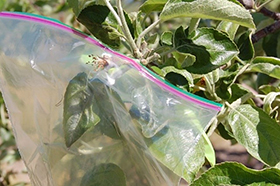
Thinned fruit cluster and bagged fruitlet.
Seventeen trees in the middle row of the old Cortland apple block at Western Ag were bagged on 06/05/19, when fruit were less than thumbnail size in width (less than 1.5 cm across). Exterior trees on either end of the row were not included. Fruit were thinned to a single fruitlet per cluster for six clusters per tree and bagged. No ladders were needed to bag fruit. Bagging time was recorded and averaged 1 minute 33 secs per fruit among the three people bagging fruit.
Orchard management

Ziploc bagged apple with earwig frass at harvest.
Exterior rows in the Cortland block followed general commercial recommendations to control codling moth, but the middle row where bagged fruit were remained untreated.
Fruit harvest

Earwigs in apple fruit stem bowl and codling moth exit hole on side of fruit
Fruit were harvested on 10/02/19 following several nights of below-freezing temperatures, with the lowest at 23 degrees F on the night of 10/01/19. The last starch-iodine test performed before frost on 09/25/19 indicated fruit averaged 2 out of 8 on the Cornell Starch-Iodine apple maturity scale. The number of bags remaining on each tree was counted, and the presence of codling moth strikes and earwig frass recorded. Following harvest of the bagged fruit, the remaining number of apples on each tree were counted and the number of fruit with codling moth strikes recorded.
Field notes and discussion
Twelve percent of bagged fruit sustained codling moth damage compared to 35% of unbagged fruit. It is not clear when infestation of bagged fruit occurred: it is possible that some eggs laid between bloom and bagging, or potentially that the slight gap between the plastic bag and fruit stem was an entry point.
Although the bags reduced the incidence of codling moth, the presence of earwig frass in 53% of the bags makes this method unappealing. This, combined with initial effort to bag, then to remove the bag with harvest, combined with only partial reduction in codling moth incidence, leads us to seek a superior simple method of codling moth control.
Summary
In 2020, we used the same 'Cortland' orchard as in the 2019 experiment; however, we used nylon mesh bags to eliminate the problem of moisture collection and earwig issues observed during the plastic bag trial. Heavy-duty nylon bags (style #1040-heavy weave; Maggot Barriers, Gloucester, MA) were purchased ($0.10 each retail price as purchased online).
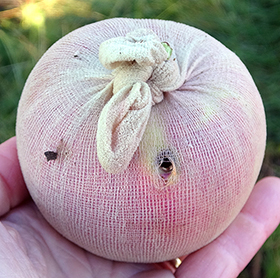
A nylon mesh bagged apple with codling moth strikes.
Bags were secured by gathering and tying the ends of the nylon tube-shaped bag around the stem (12 bags per tree). This process took on average 1 min 7 sec per fruit cluster. For the control treatment, the remaining clusters on the tree were hand-thinned to one fruitlet per cluster.
Orchard management, harvest procedures and laboratory methods were similar to the 2019 experiment. Because of forecasted frost, fruit were harvested on 30 Sept. 2020, and pooled into bins according to treatment.
These bags did not significantly reduce the incidence of codling moth. Nylon bagging affected fruit quality; the SSC was lower, TA was lower, and the fruit peel color on the nonred side of fruit (sometimes called “background color”) was greener.
Failure of the nylon bags may have been attributable to eggs laid before bagging, eggs laid or larvae burrowing through bagging, or improper bag application methods.
Individual fruit bagging
In 2021, we used the same ‘Cortland’ orchard (Corvallis, Montana) to repeat 2019 and 2020 individual fruit bagging experiments, with the following modifications:
- Horticultural oil was sprayed on a subset of the trees prior to bagging in an attempt to smother any codling moth eggs
- A portion of the MBs was pre-treated with a kaolin solution to target any larvae that may hatch inside the bags
- Bag hold-fastness was improved by adding twist ties to the MBs and taping the openings of the Ziploc bags in addition to stapling them on either side of the fruitlet stem.
Whole tree bags
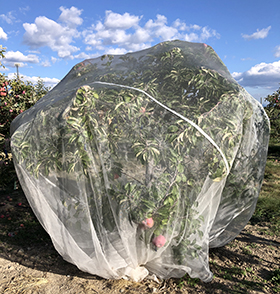
Bagged apple tree.
In a concurrent but separate experiment, we bagged whole trees with insect exclusion netting (Agfabric Insect Barrier Netting, 100% new PE, UV stabilized, white, mesh size 0.03 x 0.03 in). The netting was purchased as 16 x 30-ft pieces (8 pieces @ $51.60 ea) that we folded in half and machine-stitched along two opposite edges to form 16 x 15-ft square “bags” with the side opposite the fold remaining open. These bags were made to fit loosely over the canopies, with the largest tree in the study being 9 ft high and 11 ft in diameter. Each bag was rolled and tied with twine to prepare for application.
Rolled bags were placed at the base of each tree to be bagged. Timekeeping began when a team of two people unrolled, tied, and applied a bag, sometimes using poles made from 1.5 in PVC tubing to guide bags over tree canopies. Each pole was approximately 5-ft-long and capped on one end with a modified tennis ball to protect the netting. If necessary, one person climbed an orchard ladder to assist with bag placement. The bag opening was secured around the tree trunk with a plastic cable tie. Excess fabric was gathered and cable-tied to avoid damage when mowing between rows.
Applying tree canopy bags (beginning with untying the rolled bag) took on average 3 minutes and 27 seconds per tree. When removing canopy bags on the day of harvest, it took one person less than 5 minutes per tree to remove, fold, roll, and tie the each bag for storage.
Fruit harvest

Example of a whole tree bag with moisture trapped between the netting and apple fruit.
We chose the harvest date of 17 Sept. 2021 by considering fruit maturity, forecasted high winds (increasing probability of more fruit drop and bag loss), predicted nighttime temperatures near freezing, and availability of labor. A sample of ten fruit on 16 Sept. 2021 averaged 4.2 on the Starch-Iodine Index, with individual fruit ranging between 1 and 6. Fruit samples were harvested into a separate bin for each tree and treatment and were individually evaluated in the field.
Fruit were assessed for risk of codling moth and other fruit damage by recording incidence of codling moth strike, earwig frass, and blemishes. We also recorded bag/fruit loss rates. Our interest in the presence of earwig frass was related to observations made in the 2019 study referenced above (Leisso, Jarrett, and Miller, 2021). A blemish was considered any large defect that diminished the appeal of the fruit for fresh consumption (e.g., would likely require removing damaged/unsightly tissue to render acceptable for fresh eating or for processing), such as bird bite marks, sun scald, cracking, and occasional severe russeting that seemed atypical to this cultivar. Shriveled fruit and bagged fruit that had been exposed due to slipping or damaged bags were not included in the study.
Laboratory tests and methods used were the same as for 2019 and 2020 experiments.
Results and Discussion
More results will be forthcoming as the data are further analyzed.
All bagging treatments reduced the risk of codling moth infestation relative to the controls. In the individual apple fruit bagging trials, rates of codling moth attack in controls (83.3%, 95% C.I. =74.7%-89.4%) were similar to the controls in the whole tree bagging trial. Whole tree bags reduced codling moth infestation rate (F1,12=64.8, p<0.001) from 89.2% (95%C.I=77.8-95.1%) in the controls to 8.5% (95%C.I=3.8-17.9%). Comparing between trials, the whole tree bags protected fruit at similar rates as MBs+Kaolin and better than Ziploc and MBs alone. The single application of horticultural oil did not alter risk of CM attack.
The percentage of blemished apples was higher in whole tree bags (16.9%) and Ziploc bags (17.7%) relative to the controls (mean= 2.8% and 6.1% in whole tree bag and individual bag trials, respectively).
WHOLE TREE BAGS - the clear winner!
Hort oil spray did not alter risk of codling moth infestation.
Pros:
- Rapid application and removal
- No mess from losing individual fruit bags during natural fruit drop
- Can store and reuse bags for multiple seasons
Cons:
- Only works to protect small- to mid-sized trees, as bag/netting sizes are limited.
- If a roll of netting is used instead of a pre-made bag, it takes about an hour of machine sewing to create one tree bag
- Any fruit that are in contact with the netting on the south-facing exterior of the canopy may experience sunburn and cracking.
After the tedious application of individual fruit bags, our research team greatly appreciated the ease of applying and removing the whole tree bags. That along with the ability to reuse the bags for multiple seasons outweighed the cons. Fruit sunburn could be prevented if care is taken to position the netting away from fruit at the canopy exterior, especially on the southern exposure.
BAG/FRUIT DROP:
Thirty percent of fruit in each treatment and controls were lost. Since fruit drop is a normal occurrence and bagging treatments did not affect loss, whole tree bagging is more labor efficient. If the individual MB bags are used, the bags could be applied when the fruit have grown to ¼-½ in diameter.
During harvest, we photographed and described various conditions of the fruit and bags (Figs. 2-7). Most individual fruit bags that remained on fruit were intact. However, we had to destroy the Ziploc bags in order to remove them from the fruit, which generated a great deal of waste. Fruit bagged with MBs often exhibited unique patterns in the peel coloring (Fig. 5). We observed several MBs and canopy bags with codling moth cocoons in the folds where the fabric had been gathered and tied (Fig. 6); therefore, these bags would need to be cleaned before storing for reuse in future seasons.
The tree canopy bags produced additional notable effects. Where the netting touched fruit at the south side of the canopy, sun scald was sometimes present (Fig. 4B). There was low incidence of insect-damaged fruit; however, this type of damage was visually more significant than for individually bagged fruit, likely due to secondary infestation by earwigs (Glen, 1975). It is possible that earwigs may have predated on first generation codling moth eggs and larvae (that existed prior to bagging and not killed by the horticultural oil), preventing subsequent generations of codling moth infestation. Earwig damage to these fruit generally obliterated any signs of codling moth (Fig. 7).
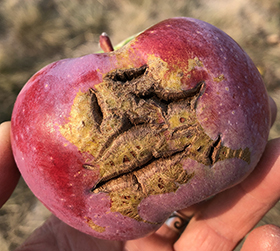
Example of sunburn and cracking that occurred on some apple fruit grown under whole tree bags.
Disclaimer. The mention of specific products used in this project does not imply endorsement by MSU.
Acknowledgement
This project is supported by a Montana Department of Agriculture Specialty Crop Block Grant.
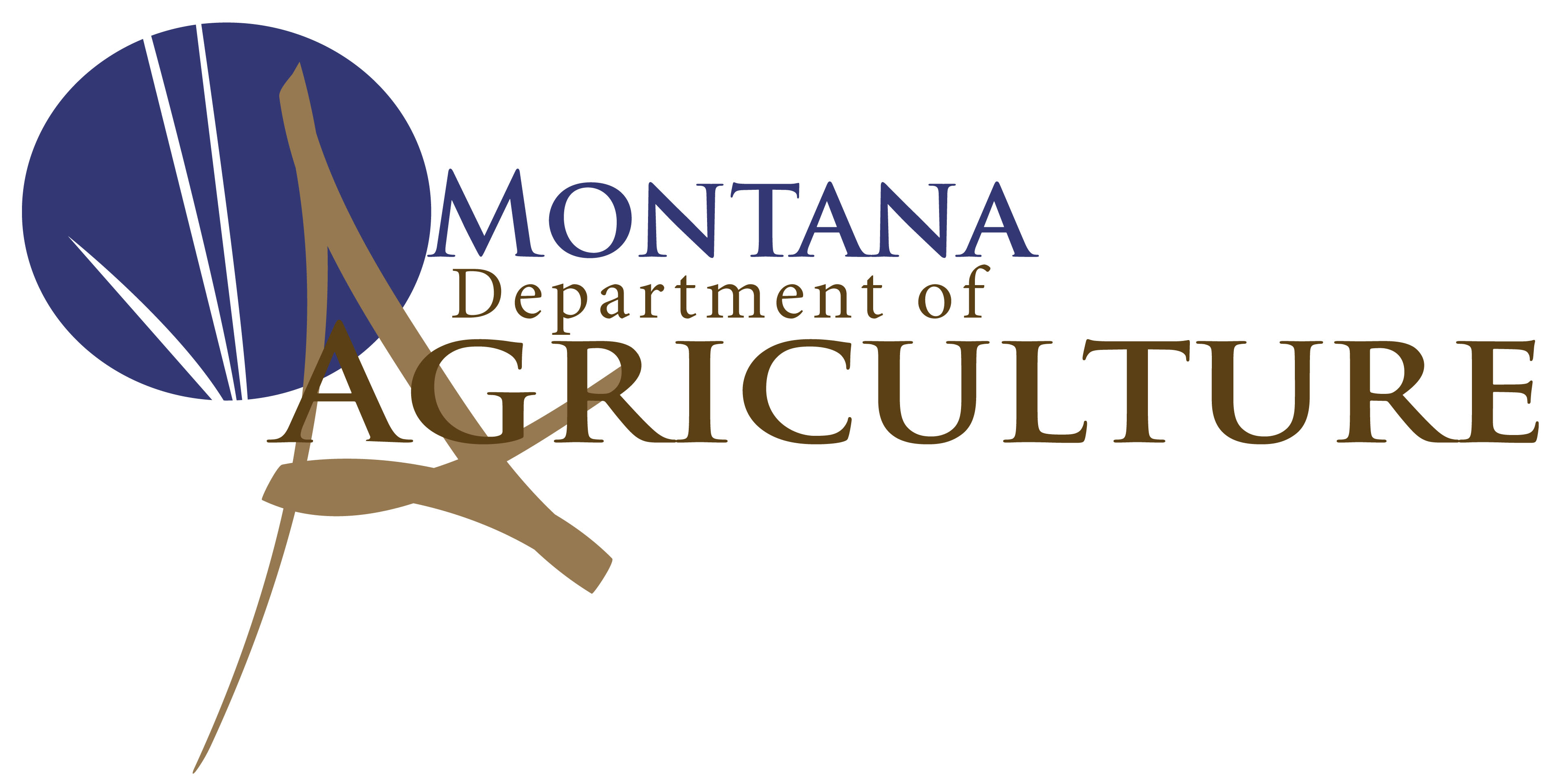
References
Leisso, R., Jarrett, B., Mendrey, K., & Miller, Z. (2021). Bagging Apple Fruit for Codling Moth Control in Western Montana, HortTechnology hortte, 31(4), 500-503. Retrieved Jul 11, 2022, from https://journals.ashs.org/horttech/view/journals/horttech/31/4/article-p500.xml


